Real-Time Wind Gusts: Key Insights for Kiteboarding


Intro
Venturing into the realm of kiteboarding, you might find yourself at the mercy of the winds that can toss you about like a leaf in a storm. Understanding real-time wind gusts is not just a matter of fancy jargon; it's crucial for both performance and safety. Why is that? Well, wind dynamics can change in the blink of an eye, making it essential for kiteboarders to read the wind like a book. In this article, we’ll peel back the layers and dive deep into the nitty-gritty of wind gusts, the gear you need, and how to ride like a pro or fend off Mother Nature's surprises.
So, whether you’re a padawan on your first kite or a weathered pro who races the gusts, this guide is crafted for you. You’ll find practical information while keeping terms simple enough to grasp, yet detailed enough to deepen your understanding. Grab your board – let's get started!
Gear and Equipment
When it comes to kiteboarding, having the right gear isn't just about convenience; it can mean the difference between a thrilling ride and a backdoor escape to the hospital. Understanding both the essential gear for beginners and the advanced equipment for experienced riders is paramount for navigating real-time wind dynamics with confidence.
Essential Kiteboarding Gear for Beginners
- Kite: The heart of your setup, it needs to be the right size based on your weight and the wind conditions.
- Board: Choose a board that fits your skill level—larger boards are typically easier for beginners as they help maintain balance.
- Harness: Supports your body while riding, allowing you to control the kite with minimal strain.
- Safety Leash: Important for detaching from the kite quickly in case of emergencies.
Each piece of gear plays a role in handling gusts. For example, a well-sized kite will respond better to sudden wind fluctuations, keeping you in control on the water.
Advanced Equipment for Experienced Riders
For those who've logged their hours and can read the water like a seasoned sailor, consider these:
- High-Performance Kites: Designed for specific wind conditions, these can handle gusts with precision.
- Directional Boards: Offering better maneuverability, they allow for sharper turns, especially in varied wind.
- Advanced Safety Systems: Such as quick-release mechanisms on harnesses that can save a rider in critical situations.
Utilizing the latest innovations in kiteboarding equipment enhances your ability to adapt to real-time gusts, ultimately resulting in a smoother, safer experience.
Techniques and Tips
Knowledge of gear goes hand in hand with effective techniques. Understanding how to maneuver in varying wind conditions is key to becoming a proficient kiteboarder. Not only can these skills keep you safe, but they can also elevate your riding game.
Basic Riding Techniques for Newbies
- Body Positioning: Keep a low center of gravity to maintain balance, especially when gusts hit.
- Edge Control: Learn to control your board’s edge to manage speed and direction.
- Kite Control: Practice moving your kite smoothly through the wind window to feel how gusts affect your lift.
Expert Tricks to Elevate Your Skills
Once comfortable, tackle more advanced maneuvers like:
- Jumping Techniques: Leveraging gusts allows for higher jumps if you know how to position the kite.
- Transitions: Shifting from one direction to another efficiently helps you stay in control even in high winds.
- Surfing the Gusts: Riding directly into the wind presents a fun challenge and opportunity to perfect your skills with gust play.
Understanding wind dynamics is key; it’s like having the wind in your sails and the ability to navigate every twist and turn.
Master these techniques and you’ll not only enjoy your time on the water, but you’ll also develop a keen sense for how to interpret real-time gusts.
By synthesizing knowledge from your gear, utilizing real-time data, and implementing effective techniques, you’ll find kiteboarding is not just about catching waves, but mastering the winds that carry you through them. Stay tuned as we continue to explore the impact of wind gusts on your performance and safety in the following sections, enhancing your kiteboarding experience into something truly spectacular.
Prelude to Real-Time Wind Gusts
When it comes to kiteboarding, knowledge about wind conditions is the lifeblood that can mean the difference between an exhilarating ride and a dangerous situation. Real-time wind gusts are at the heart of this understanding, as they influence kite performance and rider safety more than many kiteboarders might realize. In this section, we’ll dive into why grasping the concept of wind gusts is so crucial for any kiteboarding enthusiast.
Why Real-Time Wind Gusts Matter
Wind gusts are sudden increases in wind speed over a short period. Recognizing these shifts can have profound effects on kiteboarding. Here are a few key points to consider:
- Safety First: Extreme gusts can catch even seasoned riders off guard, leading to crashes or more severe incidents. Awareness helps anticipate challenging conditions.
- Performance Optimization: Understanding wind gust patterns allows kiteboarders to refine their techniques, altering their approach based on real-time data.
- Gear Selection: Kite size and type play a critical role, and knowing the expected wind gusts can help decide what equipment to use. For instance, if gusts are frequent and unpredictable, choosing a smaller kite might be more prudent.
The Benefits of Staying Informed
By monitoring real-time wind gusts, kiteboarders can boost their overall experience out on the water.
Here are a few benefits:
- Enhanced Decision Making: Navigating conditions effectively hinges on timely information about wind changes, enabling quicker responses and informed choices.
- Community Insights: Engaging with fellow kiteboarders at local spots can lead to shared real-time updates. Information exchange strengthens the collective understanding of the area’s wind dynamics.
- Exciting Adventures: Real-time awareness can open up opportunities for thrilling rides during optimal conditions while minimizing risks associated with sudden wind shifts.
"Understanding the wind isn't just about physics; it’s crucial for survival and success on the water."
Culmination
In sum, grasping the intricacies of real-time wind gusts is imperative for kiteboarders of every skill level. The benefits extend from individual safety to enhanced performance, fostering a deeper connection with the sport and nature itself. As we dive deeper into this article, we will uncover the science behind wind gusts, the factors that influence them, and how to track their patterns effectively to enjoy every ride safely.
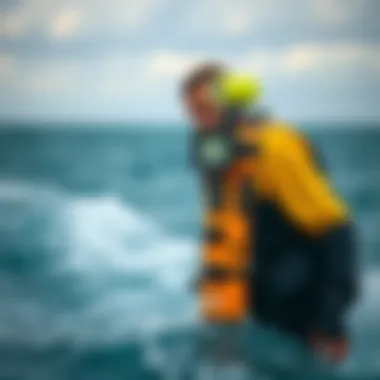
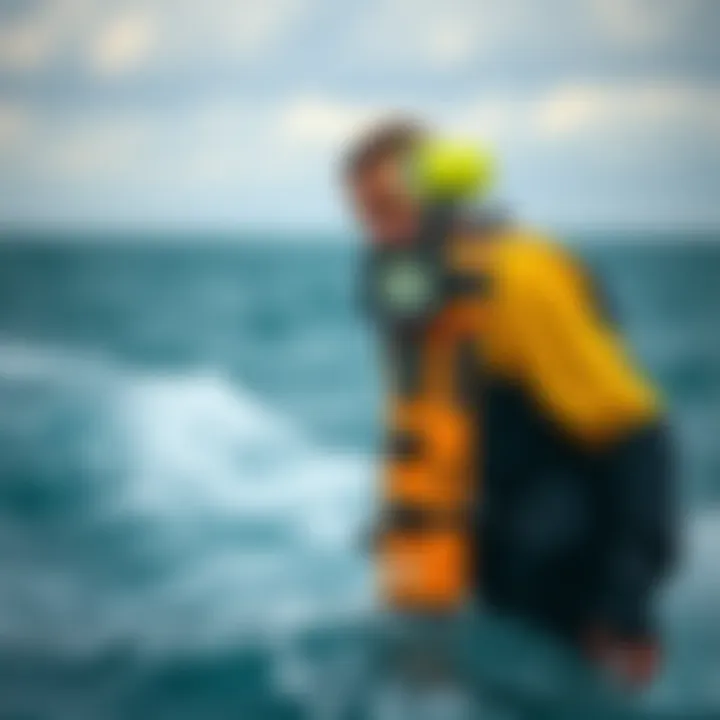
The Science of Wind: What Are Wind Gusts?
When you’re out on the water, feeling the thrill as you glide across the surface, understanding wind gusts can be the difference between a delightful ride and a challenging one. This segment dives deep into the very essence of wind gusts - what they are, how they form, and why they matter immensely for kiteboarders and outdoor enthusiasts alike.
Definitions and Key Terminology
At the foundation, it’s vital to grasp what we mean when we say "wind gusts." A wind gust is essentially a brief, intense burst of wind that can appear and disappear within seconds. Concepts such as "sustained wind" and "peak wind gust" become critical here. Sustained wind is what you feel blowing steadily, while the peak gust is that wild rush that takes you by surprise.
- Sustained Wind: The steady wind speed measured over a specific time frame, usually one minute.
- Peak Wind Gust: The highest speed reached during a given period; usually knocks the wind right out of your sails.
- Breezy: A common term used to refer to gentle winds, often pleasantly felt during kiteboarding.
Understanding these terms isn’t just academic; it builds the basis for making sound decisions during kiteboarding excursions.
Mechanics of Wind Formation
So, how do these gusts materialize? Picture it like the atmosphere is a giant pot on a stove, with its temperature variations creating different currents. As the sun heats the ground, different terrains heat up at different rates, causing variations in air pressure. This creates winds that can swing from mild breezes to ferocious gusts.
- Temperature Differences: Hot air rises while cold air sinks; this continually shifts air masses, generating wind movements.
- Topography: Mountains, valleys, and rivers can divert and channel winds in often surprising ways, leading to sudden gusts.
- Weather Systems: Storm fronts, high-pressure, and low-pressure systems can push air through spaces faster than you can say "kiteboarding."
Gusts often happen when the wind hits an obstacle like a building or a tree, causing it to swirl and eddy. This is known as turbulence, and it’s the nemesis of smooth wind flow.
Knowing how these gusts form isn't just for trivia night; it helps kiteboarders predict and react to changes, ensuring safety and maximizing performance. The intricacies of wind gusts speak to the nature of wind itself, showcasing how layered and complex our understanding must be if we aim to navigate the unpredictable world of kiteboarding.
As you unpack the mechanics of wind, keep in mind that knowledge is power. The more you know about the winds around you, the better prepared you are for the thrilling – and sometimes daunting – challenges of kiteboarding.
Factors Influencing Wind Gusts
Understanding the factors that influence wind gusts is crucial for kiteboarders. These gusts can dramatically affect performance, safety, and overall enjoyment on the water. Knowing what conditions create these fluctuations can help kiteboarders make informed decisions, maximizing their time on the water while minimizing risks.
Topography and Geography
The lay of the land plays a significant role in wind behavior. High hills, mountains, and large bodies of water can change how wind blows and creates gusts. For instance, if you're kiteboarding near a mountain, you might experience stronger winds as the air funnels through valleys. Conversely, open plains tend to have steadier winds, which can be more favorable for kiteboarding.
Curiously, coastal regions also exhibit their unique wind patterns. The interaction between land and sea creates thermal breezes. During the day, land heats up faster than water, causing the air above the land to rise and create a vacuum that pulls in cool sea air. This can lead to consistent wind speeds ideal for kiteboarding. However, the proximity of gullies or dunes can lead to unpredictable, turbulent conditions, which every kiteboarder needs to be attuned to.
Weather Patterns and Systems
Wind is not just about local geography; larger weather systems significantly influence wind gusts. When a cold front moves in, the difference in air pressure can temporarily spike wind speeds, resulting in sudden gusts. Understanding weather forecasts is key. Wind can shift quickly, and knowledgeable kiteboarders recognize how approaching systems may affect conditions on the water.
In addition, systems like thunderstorms bring unpredictable gusts that can reach dangerous levels. Systematic weather tools help predict these changes, aiding kiteboarders in planning their sessions more safely. It's all about reading the signs in the sky; clouds, temperature changes, and atmospheric pressure can all provide clues to the potential for gusty winds.
Human Factors and Urban Impact
Urban areas can have a dramatic influence on wind patterns due to the presence of tall buildings and other man-made structures. These obstacles can create wind tunnels, concentrating gusts in certain areas. Therefore, kiteboarding near cities requires a heightened awareness of how these structures might affect your ride.
Moreover, the heat generated by urban environments leads to thermals, complicating wind dynamics further. This is crucial for kiteboarders, as thermal winds can be fierce and unpredictable. It’s essential to consider the local geography’s interaction with human development, as this may present a mixed bag for performance.
Kiteboarders must remain observant and flexible, knowing that a simple urban structure can shift the entire wind profile, sometimes within a matter of minutes.
"Wind, in all its forms and behaviors, becomes the very friend or foe of kiteboarders. Understanding it is not just useful; it is essential."
With the factors affecting wind gusts clearly outlined, kiteboarders can better prepare for their time on the water, balancing enjoyment with safety, all while riding the breezy waves.
Real-Time Data: Tracking Wind Gusts
Kiteboarding isn't just about hopping on a board and riding the wind; it's a delicate dance with nature that hinges on understanding real-time data regarding wind gusts. Without timely information, kiteboarders risk facing unpredictable wind conditions that could turn a leisurely ride into a perilous situation. Tracking wind gusts in real-time not only enhances performance but also ensures safety on the water.
Real-time data serves as a lifeline for kiteboarders, offering insights that can be the difference between a day of thrilling adventure and one of frustration or danger. Various technologies and platforms have emerged to provide those much-needed updates. By tapping into these resources, riders can adapt their techniques on the go, optimizing their experience while minimizing risk. This section dives into the various methods available for tracking wind gusts, focusing on the tools that make real-time data reliable and accessible.
Technologies for Measurement
The arsenal of tools available for measuring wind is diverse and continuously evolving. At the heart are anemometers, devices that measure wind speed and direction, crucial for real-time analysis. The latest models, often found in meteorological stations, offer minute-by-minute data, painting a clear picture of current wind conditions.
Portable anemometers have become increasingly popular among kiteboarders, especially those who prefer to gauge conditions at specific locations rather than relying solely on data from nearby weather stations. This allows riders the versatility to know how wind direction might shift when at a particular beach or spot.
Other advanced technologies include Doppler radar systems and satellite imaging, which provide broader insights into wind patterns across larger areas. While these might not give real-time gusts specific to a boarder's immediate vicinity, they can indicate larger, influential wind systems approaching.
Crowdsourced Weather Data
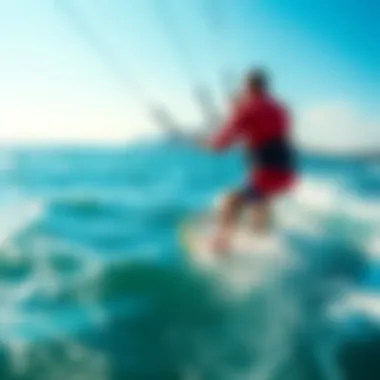
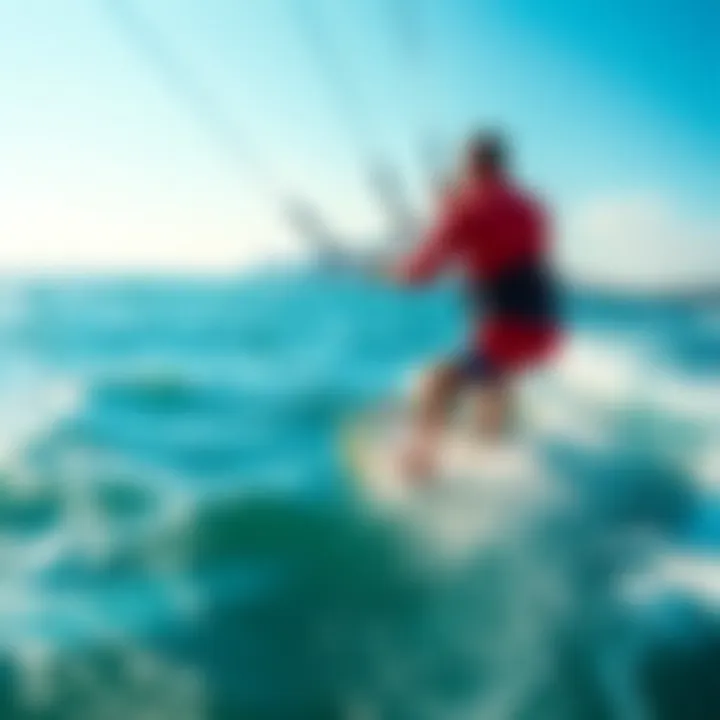
In today's digital age, communities abound when it comes to gathering insights on weather conditions, and kiteboarding is no exception. Crowdsourced weather data has become an integral part of wind tracking. Websites and platforms allow users to contribute their own data, sharing information about local wind conditions with other enthusiasts. This is particularly useful for kiteboarders who are reliant on experiences shared by other riders in their area.
This data often includes wind speeds, gusts, and even personal anecdotes about conditions, allowing for a rich tapestry of localized weather information. Kiteboarders can glean from others' experiences, heightening their understanding of how wind behaves at certain spots.
Among popular platforms, Windy.com and Kitesurfing.com are resources worth noting. They combine professional weather data with user-generated content, paving the way for comprehensive insights. Harnessing these platforms means being part of a community, giving and receiving timely information about ever-shifting wind conditions.
Mobile Apps and Online Platforms
Smartphones have transformed how kiteboarders engage with wind data. Mobile apps have emerged as indispensable tools, providing updates tailored for those out on the water. Applications such as Windy and Kitemana offer real-time alerts, forecasts their users can trust, and easy-to-read graphs that make understanding wind data less daunting.
These platforms don't just regurgitate data; they present the information in practical formats to help kiteboarders make quick decisions. Moreover, the portability allows riders to check conditions on the go, which is vital when looking to time a perfect session.
Additionally, many of these apps include social features where users can share their real-time experiences and even create meet-up groups. By doing so, kiteboarders aren’t just keeping themselves informed; they’re fostering a connected community, all while keeping an eye on those elusive wind gusts.
By leveraging technology for real-time tracking, kiteboarders can navigate the complexities of wind dynamics with confidence, maximizing their riding experience and safety.
Living with Wind Gusts: Safety Considerations
Kiteboarding is an exhilarating sport that draws individuals towards the windswept waters, uniting them with nature's raw forces. While the thrill of catching air and carving through waves is unparalleled, understanding how to navigate the unpredictable nature of wind gusts is vital for safety. In this section, we will delve into crucial safety considerations that every kiteboarder must keep in mind when confronted with high winds.
Understanding Wind Limits for Kiteboarding
Every kiteboarder has to develop a keen sense of wind limits, which can be quite complex yet essential. Wind gusts can vary in intensity and duration, and recognizing these variations is a matter of both skill and experience.
- Know Your Gear: Different kites are designed to perform best within specific wind ranges. For instance, a smaller kite might be suitable for strong winds, while a larger kite excels in lighter conditions. Familiarize yourself with your equipment to ensure you're selecting the right gear suitable for the day’s wind conditions.
- Personal Skill Level: Understanding your capabilities as a rider is equally crucial. A novice might find it challenging to maintain control in stronger gusts, while a seasoned rider may feel more confident handling them. Make sure you assess your current skill level honestly and ride within your comfort zone.
- Gust Characteristics: Wind doesn’t always blow steadily; gusts are brief bursts of increased wind speed. They can appear and disappear quickly, making it tricky to anticipate changes. It's essential to stay alert to any sudden shifts in wind patterns, as they can dramatically alter your experience on the water.
"Mastering the wind means respecting it. Ignoring warnings can lead to mishaps that might put not only yourself but also others at risk."
Emergency Protocols for High Winds
Despite the best preparations, conditions can change with little warning. Thus, kiteboarders should have a clear plan in place for emergencies that could arise from high winds. Here are some effective protocols to consider:
- Know When to Call It a Day: If gusts exceed safe riding limits or conditions become too turbulent, it's prudent to pack up for the day. There’s no shame in recognizing when the weather isn’t on your side.
- Clear Communication: When out kiteboarding, ensure you understand signals with fellow riders. Establish a clear line of communication in case help is needed, making it easier to react quickly if conditions worsen.
- Gain Local Knowledge: Tapping into the local kiteboarding community can provide invaluable insights. Places often have inherent wind patterns; local riders can share their experiences and tips on when to ride and when to stay ashore.
- Emergency Gear: Always carry a basic emergency kit that includes a whistle, signaling mirror, or even a personal locator beacon. These could prove vital should you find yourself in distress.
- Practice Rescues: Regularly practicing self-rescue techniques in calm conditions can prepare you for high stress situations. Familiarize yourself with how to deflate your kite in the water and methods to return to shore safely if caught in a rough patch.
By understanding and applying these safety considerations, kiteboarders can enjoy their time on the water with greater confidence. Just as in life, knowing the lay of the land—or in this case, the wind—can make all the difference in having a thrilling yet secure experience.
Maximizing Kiteboarding Performance with Wind Knowledge
Wind knowledge is not just an advantage, it’s the very backbone of an exhilarating and safe kiteboarding experience. Understanding how to read the wind and adjust one’s techniques accordingly can significantly enhance performance, proving crucial whether you’re a beginner kiteboarder learning the ropes or an experienced athlete pushing the limits.
One major benefit of grasping wind dynamics is the ability to anticipate changes. Winds can shift like a cat on a hot tin roof—sudden gusts can turn an average session into an unforgettable ride or vice versa. By being aware of how to interpret wind conditions, kiteboarders can make informed decisions that affect their maneuvers, stunts, and overall control on the water. This forms a solid foundation for mastering intricate tricks or simply enjoying the ride to its fullest potential.
When kiteboarders understand the nuances of wind patterns, they can adapt their techniques on the fly. Adjusting your stance, line tension, or even the angle of the kite can mean the difference between soaring through the air and floundering in the water. For instance, if there’s a sudden increase in wind speed, a rider may need to lower the kite or change their body position to maintain balance. Without this adaptability, a miscalculation could lead to falls or unwanted tumbles.
In summation, maximizing performance hinges on a kiteboarder’s ability to not only anticipate wind gusts but to respond effectively. By mastering this knowledge, riders augment their skills tremendously, creating a more dynamic and skilled approach to kiteboarding.
Adjusting Techniques Based on Wind Conditions
When it comes to kiting, the wind can sometimes feel like a fickle friend. The way a kiteboarder adjusts their techniques based on current wind conditions determines their ride quality.
For instance, on lighter wind days, a kiteboarder may lean more toward a steering-heavy technique, using their body weight shift to ride upwind more effectively. Conversely, when grappling with heavier winds, the focus should shift to maintaining a steady kite position and controlling the pull to avoid being yanked off balance. Knowing how to adjust your style takes a lot of practice, experience, and often, a little trial and error.
Some techniques to consider can include:
- Body Positioning: Changing your center of gravity can help maintain stability. If the wind kicks up, crouching slightly lowers your center, making you less likely to be lifted.
- Kite Control: Understanding where to fly your kite—the sweet spot—is critical. In strong winds, keeping the kite lower in the window can help manage power while offering more control.
- Trimming Lines: Adjusting line length for different conditions also provides finer control over kite responsiveness.
Ultimately, the goal is to harness wind energy without letting it get the better of you. Experience will teach you the delicate balance between finesse and aggression in your riding style.
Choosing the Right Gear for Wind Variations
When setting out for a kiteboarding adventure, gear selection can feel like hunting for gold in a haystack. Choosing the right kite, board, and accessories to match wind variations is essential.
One fundamental factor is kite size. On lighter wind days, kiteboarders may benefit from larger kites that can catch more wind and generate power. Conversely, smaller kites provide better control and responsiveness in high-wind situations. The transition from a 12m kite to a 9m can also mark a significant leap in navigating varying wind conditions.
Besides kite size, the board can also greatly impact performance. For instance, a larger board can provide buoyancy in lighter winds, ensuring you don’t get stuck in the water. A smaller board gives more maneuverability but requires stronger winds to maintain lift. Pay attention to bottom shapes—concave or rocker profiles can influence how a board rides over the waves.
Finally, don’t forget about the less visible gear—lines and harnesses. Thinner lines can improve performance in high winds due to less drag, while a well-fitted harness offers comfort and better weight distribution, contributing to an overall enhanced experience.
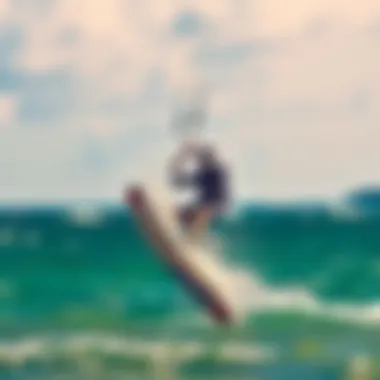
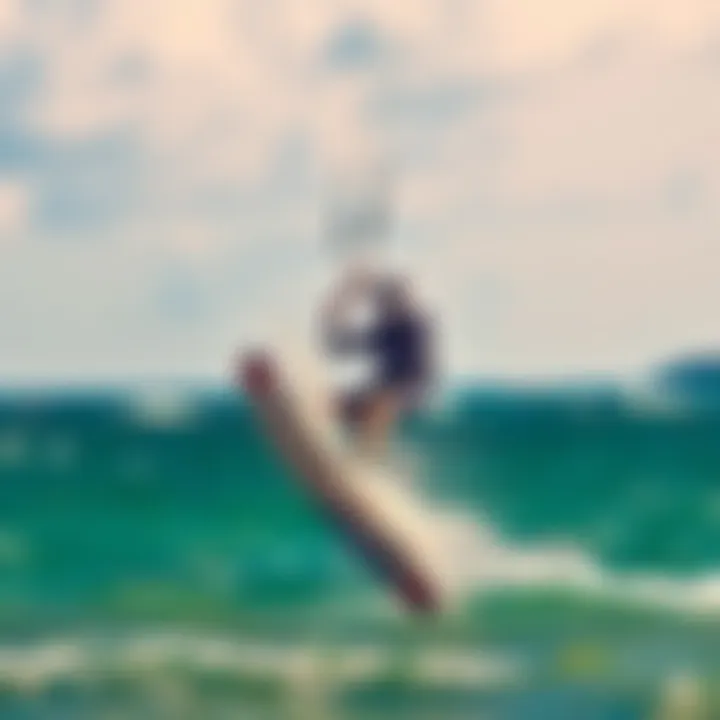
In this sport, blending knowledge of the wind with the right gear choices helps kiteboarders transform potential challenges into exhilarating rides.
The Role of Wind Forecasting in Kiteboarding
Wind can be as fickle as a cat on a hot tin roof, changing unexpectedly and often dramatically. Understanding how to predict these shifts is crucial for kiteboarders. Wind forecasting plays a pivotal role in kiteboarding for several reasons. First and foremost, accurate wind predictions can mean the difference between an exhilarating ride and a hazardous situation. Kiteboarders rely heavily on these forecasts to plan their outings, ensuring they have the right conditions for both safety and performance.
Predictive Models and Tools
To help kiteboarders navigate the gusty seas of wind dynamics, various predictive models and tools are at their disposal. Many of these tools are rooted in meteorological science, leveraging advanced algorithms to synthesize data from multiple sources. Some notable models include:
- Numerical Weather Prediction (NWP): This approach utilizes mathematical formulas to simulate the atmospheric conditions, providing detailed forecasts on wind patterns, temperature, and precipitation.
- High-Resolution Local Models: These models focus on smaller geographic areas, giving kiteboarders insights into local wind variations that larger models might miss. They take into account factors like topography and urban development.
- Real-Time Data Integration: Platforms that pull in real-time information from weather stations, buoys, and satellites offer timely updates that are critical for making pre-session decisions.
Mobile apps like Windy and Kitelog also combine these predictive models into user-friendly interfaces. These tools can effectively show kiteboarders current conditions, trends, and forecasts over various timelines, making them indispensable for any serious rider.
Interpreting Forecast Data Effectively
Let's be honest; not everyone can decipher a weather map at first glance. Understanding how to interpret wind forecast data is as vital as knowing when to launch your kite. Here are some important considerations:
- Wind Speed and Direction: Grasp the basics. Wind is not just about speed; understanding direction is key. A side-shore breeze might be perfect for a day out, but a strong onshore wind can lead to dangerous conditions.
- Gust Potential: Look for indications of gusty conditions within the forecast. Forecasts usually highlight if there will be sudden spikes in wind speed. Be mindful of these, as they can be unpredictable and require quick reflexes.
- Ask the Right Questions:
- Local Knowledge: Engage with local kiteboarding communities. Forums on platforms like Reddit or Facebook groups can provide invaluable anecdotal insights that no predictive model can fully capture.
- Is the wind veering or backing?
- How do modeled conditions compare against actual measurements from local reporting stations?
- What are the typical weather patterns for this time of year?
"Understanding the wind is like learning a new language. The better you grasp the nuances, the more fluent you'll be in the sport."
In essence, developing an aptitude in interpreting wind forecasts not only enhances your kiteboarding experience but also significantly boosts your safety on the water. Mastering these tools and insights can pave the way for many successful sessions ahead.
Experiences of Kiteboarders: Real-Life Perspectives
The insights drawn from kiteboarders' experiences are invaluable for anyone looking to navigate the nuanced world of wind gusts. Real-life perspectives provide a lens through which one can understand how wind dynamics play out in practical scenarios. This section emphasizes the importance of anecdotal evidence in the kiteboarding community, highlighting the distinct benefits, considerations, and challenges that real riders face in varying wind conditions.
Anecdotal Accounts of Wind Challenges
Every kiteboarder has faced their share of windy curveballs. Take for example a seasoned rider recounting a day at a popular spot. It started off with a seemingly perfect breeze—consistent at about 15 knots. Yet, as they launched their kite, the wind began to shift unexpectedly, with gusts reaching a wild 25 knots. This kind of story is not rare. Riders often share tales of misjudged wind forecasts that led to unexpected tumbles or even dangerous situations on the water.
Wind is a fickle companion; what begins as a gentle breeze can morph into fierce gusts in the blink of an eye. These anecdotes serve as cautionary tales, underscoring the need for kiteboarders to be acutely aware of their surroundings and to respect the winds. Whether it’s the sudden gust that flips a rider into the water or the sporadic lull that catches them off guard, understanding these challenges helps in making more informed choices on the water.
- Gusty Days: A rider recalls a day when the wind was so unpredictable that they changed spots twice to find a more stable breeze.
- Overcoming Obstacles: Another rider recounts a close call where they had to quickly adapt their technique due to a sudden increase in wind. They learned that agility and awareness can turn a potential disaster into a thrilling adventure.
These stories illustrate how kiteboarding not only tests physical skills but also demands mental fortitude. It’s about assessing the conditions and making swift decisions while seamlessly adapting to nature’s whims.
Tips from Seasoned Riders
Learning the ropes from more experienced kiteboarders can offer a wealth of knowledge. Here are a few tried-and-true tips shared from seasoned riders that can assist both novices and seasoned veterans alike:
- Stay Tuned to Your Surroundings: Keep an eye on the flags and trees around you; they are excellent indicators of wind changes. Being vigilant can mean the difference between smooth sailing and a bumpy ride.
- Practice in Varied Conditions: Get out there when conditions aren’t perfect. Riding in diverse wind gusts will not only improve your skills but will also teach you about how different kites respond to varying forces.
- Consult the Locals: Nothing beats the insights of local riders who know their home waters. They can inform you about common wind patterns and potential hazards that may not show up on a forecast.
- Use Technology Wisely: Make the most of apps and websites that provide real-time data on wind conditions, but remember, tech isn’t perfect. Cross-reference multiple sources and always have a plan B.
By listening to the experiences and advice of those who have weathered both calm and tumultuous days on the water, kiteboarders can greatly enhance their approach to navigating wind gusts. Building a solid foundation of knowledge will equip riders not just to handle wind dynamics, but to truly enjoy the thrill of kiteboarding.
Finale: Mastering Wind Dynamics
In kiteboarding, understanding the complexities of real-time wind gusts goes beyond mere enjoyment of the sport; it is essential for safety and performance. Kiteboarders are often at the mercy of the wind, and knowledge about gusts can make the difference between a thrilling ride and a dangerous situation. By mastering the dynamics of wind, enthusiasts can predict how gusts will affect their flight and adjust accordingly.
The importance of honing this understanding lies in several key areas:
- Safety: Familiarity with wind patterns can significantly reduce the risks associated with kiteboarding. Knowledgeable riders can avoid unfavorable conditions and make informed decisions about when to launch or land their kites.
- Performance: Understanding how to manage wind gusts allows kiteboarders to enhance their performance. When riders adjust their technique based on gust forecasts, they can achieve smoother rides and utilize the wind to their advantage instead of battling against it.
- Community Wisdom: Sharing experiences about wind dynamics can foster a sense of community among kiteboarders. Each rider’s unique insights into handling gusts contribute to a greater body of knowledge which can be invaluable for newcomers.
Overall, mastering wind dynamics is not an option; it’s a necessity for anyone serious about kiteboarding.
Final Thoughts on Wind Gusts
As this article illustrates, real-time wind gusts are not just unpredictable whispers of nature but powerful forces that shape the kiteboarding experience. Wind gusts can change within moments, influenced by a myriad of factors, from geographical features to weather patterns. Riders must develop a sensitivity to these shifts, recognizing that a gust can provide that exhilarating boost or, conversely, pose a serious risk.
Every kiteboarder has stories that illustrate these crucial moments—when the wind carries them higher and further, or when a challenging gust tested their skill and resolve. Hence, embracing a proactive mindset towards understanding wind dynamics will undoubtedly set kiteboarders apart.
Future Trends in Wind Measurement and Forecasting
Looking ahead, advancements in technology promise to refine how kiteboarders track and understand wind gusts. Some trends to anticipate include:
- Enhanced Mobile Apps: Expect more sophisticated kiteboarding apps that utilize AI and machine learning to deliver hyper-local wind forecasts. These applications will not only provide current conditions but will also learn from user data to improve their accuracy over time.
- Real-Time Data Integration: The fusion of data from personal weather stations, professional meteorological sources, and local forecasts will enable kiteboarders to access rich, real-time information. This comprehensive dataset will aid in predicting gust patterns with greater accuracy.
- Community-Driven Insights: Innovations in crowdsourced data gathering will allow kiteboarders to contribute to and benefit from real-time reports of wind conditions in specific locations. Platforms could evolve to feature live updates from riders on current wind gust conditions, forming a communal safety net.
Riders who keep an eye on these trends will not only enhance their experience but also ensure they have a safer ride. By embracing these tools and advancements, kiteboarders can stay ahead of the curve and continue to enjoy the thrill of catching wind without a hitch.
"The wind is a reminder of nature's unpredictability; respect it, and it will respect you in return."
By remaining informed and proactive, kiteboarders can truly master the art of riding the winds.















